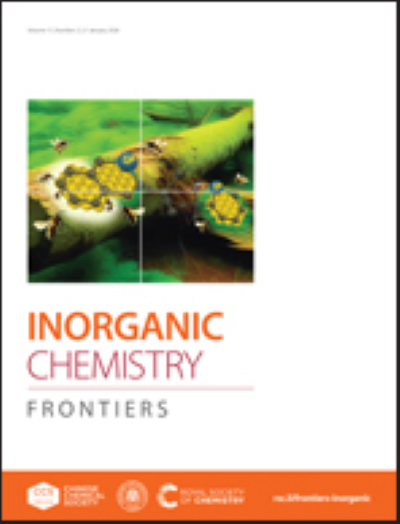Synthesis and photocatalytic evaluation of first nickel dioxo-haloselenate complexes immobilized on mesoporous TiO2 for enhanced solar-driven hydrogen production
IF 6.1
1区 化学
Q1 CHEMISTRY, INORGANIC & NUCLEAR
引用次数: 0
Abstract
[NiBr(SeO2Br)(bipy)2] (1), [NiBr(SeO2Br)(phen)2] (2), and [NiCl(SeO2Cl)(bipy)2] (3), represent the first nickel complexes incorporating dioxo-haloselenate anions. These complexes were selected due to their unique structural features, and light absorption properties, which make them promising candidates for photocatalytic applications. The compounds were immobilized onto mesoporous TiO2 (m-TiO2), resulting in photocatalysts 1@m-TiO2, 2@m-TiO2, and 3@m-TiO2, which were evaluated for solar-driven water splitting to produce hydrogen. Electrochemical analyses revealed suitable HOMO–LUMO energy levels for visible-light activation, and X-ray photoelectron spectroscopy confirmed changes in surface composition upon immobilization. Among the photocatalysts, 2@m-TiO2 exhibited the highest H2 production, achieving 927 μmol g−1 in 6 hours, outperforming both 1@m-TiO2 (803 μmol g−1) and 3@m-TiO2 (810 μmol g−1), as well as reference materials m-TiO2 and Degussa P25. Moreover, complex 1 demonstrated intrinsic electrochemical activity for H2 evolution in acidic media. Recycling experiments showed the stability of 2@m-TiO2 over three cycles, confirming its robustness. These findings not only demonstrate the effective cocatalytic role of complexes 1–3 in enhancing H2 generation but also shed light on interfacial photo-induced processes via HOMO–LUMO evaluation and XPS analysis. This study introduces the first example of nickel-based dioxo-haloselenate complexes as cocatalysts, opening new avenues for the development of sustainable hydrogen-evolving materials.

介孔TiO2固定化二氧代卤化硒酸镍配合物的合成及光催化评价
[NiBr(SeO2Br)(bipy)2](1)、[NiBr(SeO2Br)(phen)2](2)和[NiCl(SeO2Cl)(bipy)2](3)是第一个含二氧代卤代硒酸盐阴离子的镍配合物。这些配合物因其独特的结构特征和光吸收特性而被选中,这使它们成为光催化应用的有希望的候选者。这些化合物被固定在介孔TiO2 (m-TiO2)上,得到了光催化剂1@m-TiO2、2@m-TiO2和3@m-TiO2,并对它们进行了太阳能驱动的水裂解制氢的评价。电化学分析表明,HOMO-LUMO能级适合于可见光活化,x射线光电子能谱证实了固定化后表面成分的变化。在光催化剂中,2@m-TiO2的H2产率最高,在6小时内达到927 μmol g−1,优于1@m-TiO2 (803 μmol g−1)和3@m-TiO2 (810 μmol g−1),也优于参比物m-TiO2和Degussa P25。此外,配合物1在酸性介质中表现出固有的析氢电化学活性。再循环实验表明2@m-TiO2在三个循环中稳定,证实了它的鲁棒性。这些发现不仅证明了配合物1-3在促进H2生成中的有效共催化作用,而且通过HOMO-LUMO评价和XPS分析为界面光诱导过程提供了线索。本研究首次引入了镍基二氧代卤代硒酸盐配合物作为助催化剂,为可持续发氢材料的开发开辟了新的途径。
本文章由计算机程序翻译,如有差异,请以英文原文为准。
求助全文
约1分钟内获得全文
求助全文
来源期刊

Inorganic Chemistry Frontiers
CHEMISTRY, INORGANIC & NUCLEAR-
CiteScore
10.40
自引率
7.10%
发文量
587
审稿时长
1.2 months
期刊介绍:
The international, high quality journal for interdisciplinary research between inorganic chemistry and related subjects
 求助内容:
求助内容: 应助结果提醒方式:
应助结果提醒方式:


